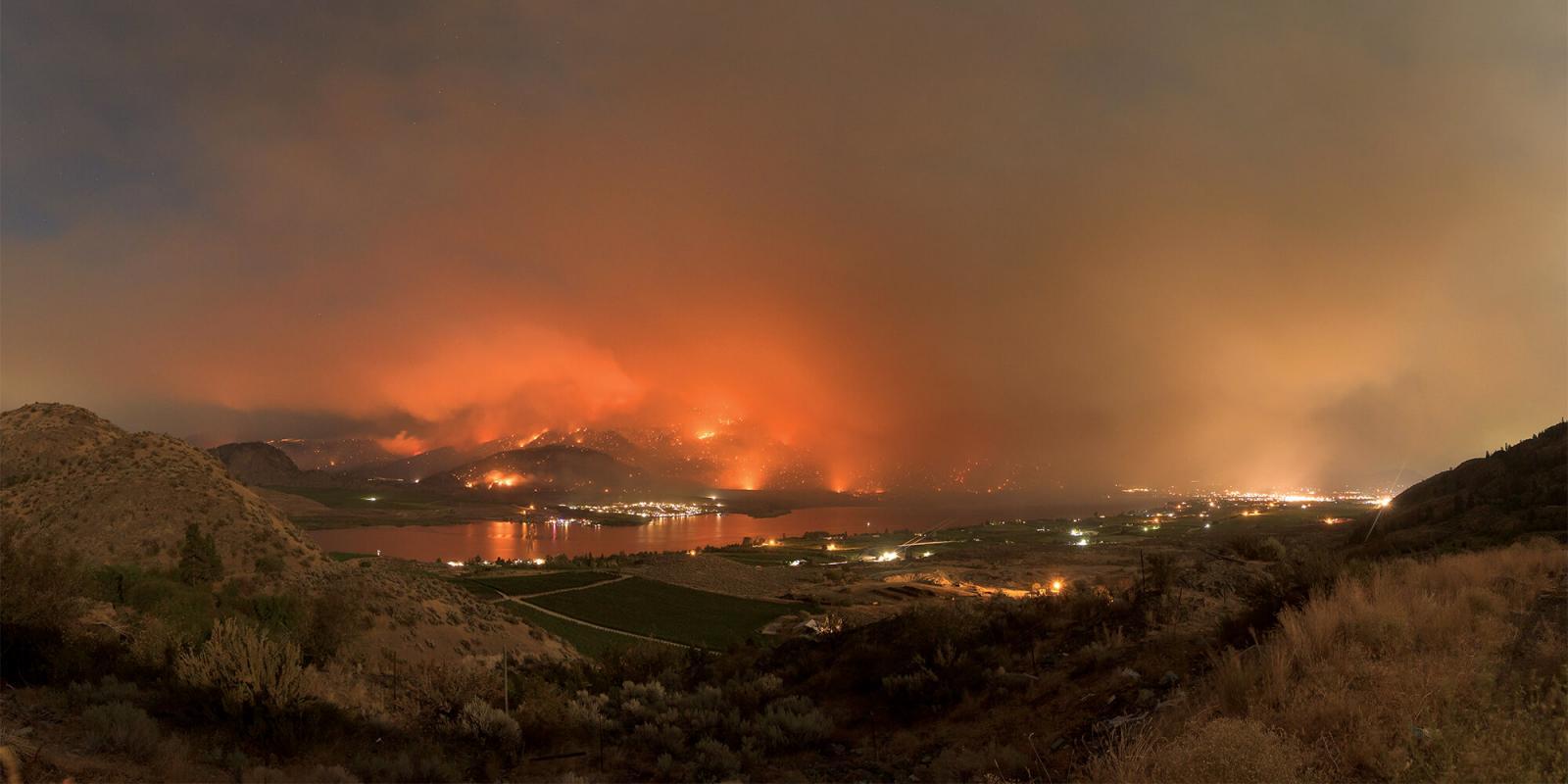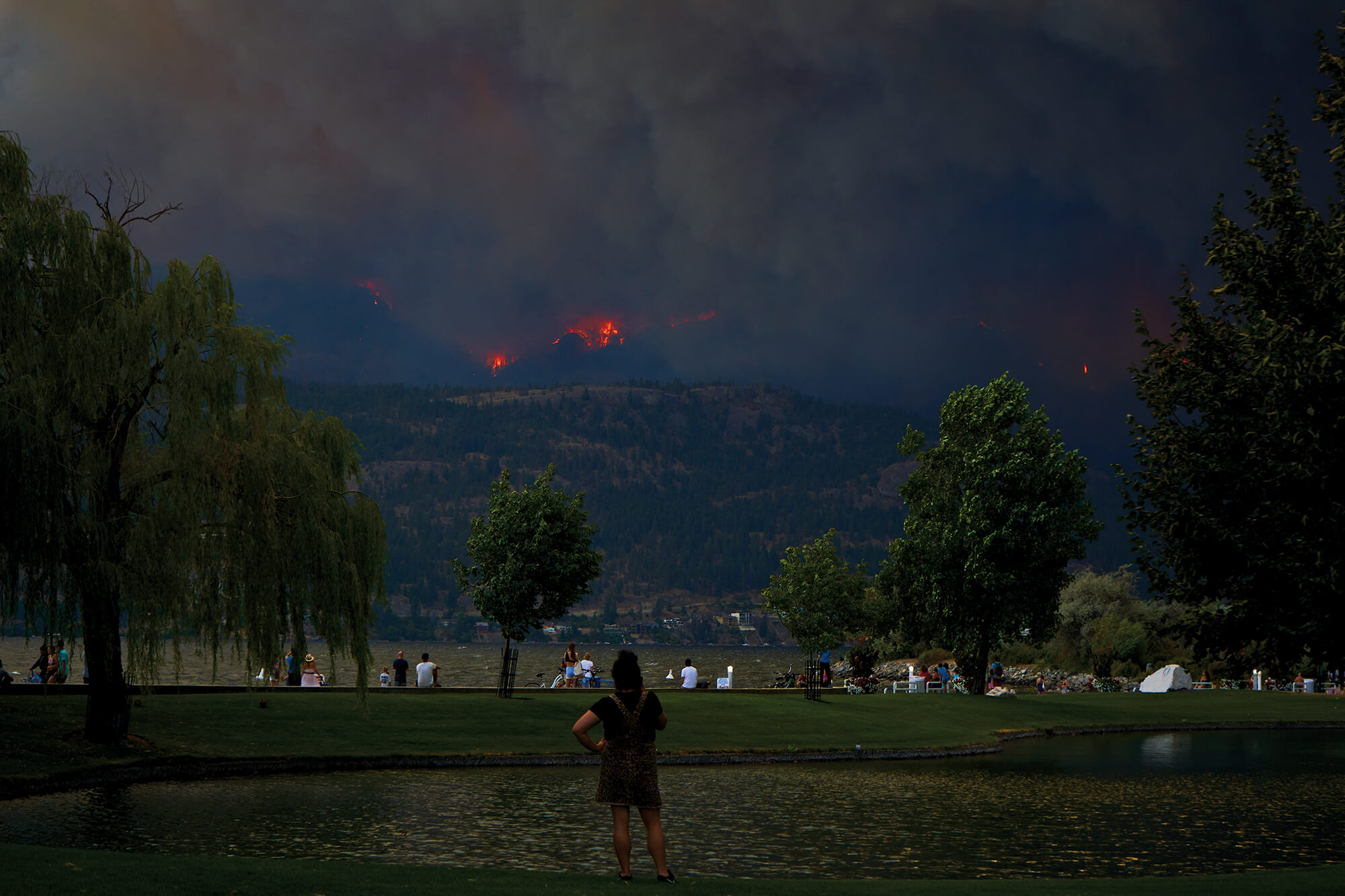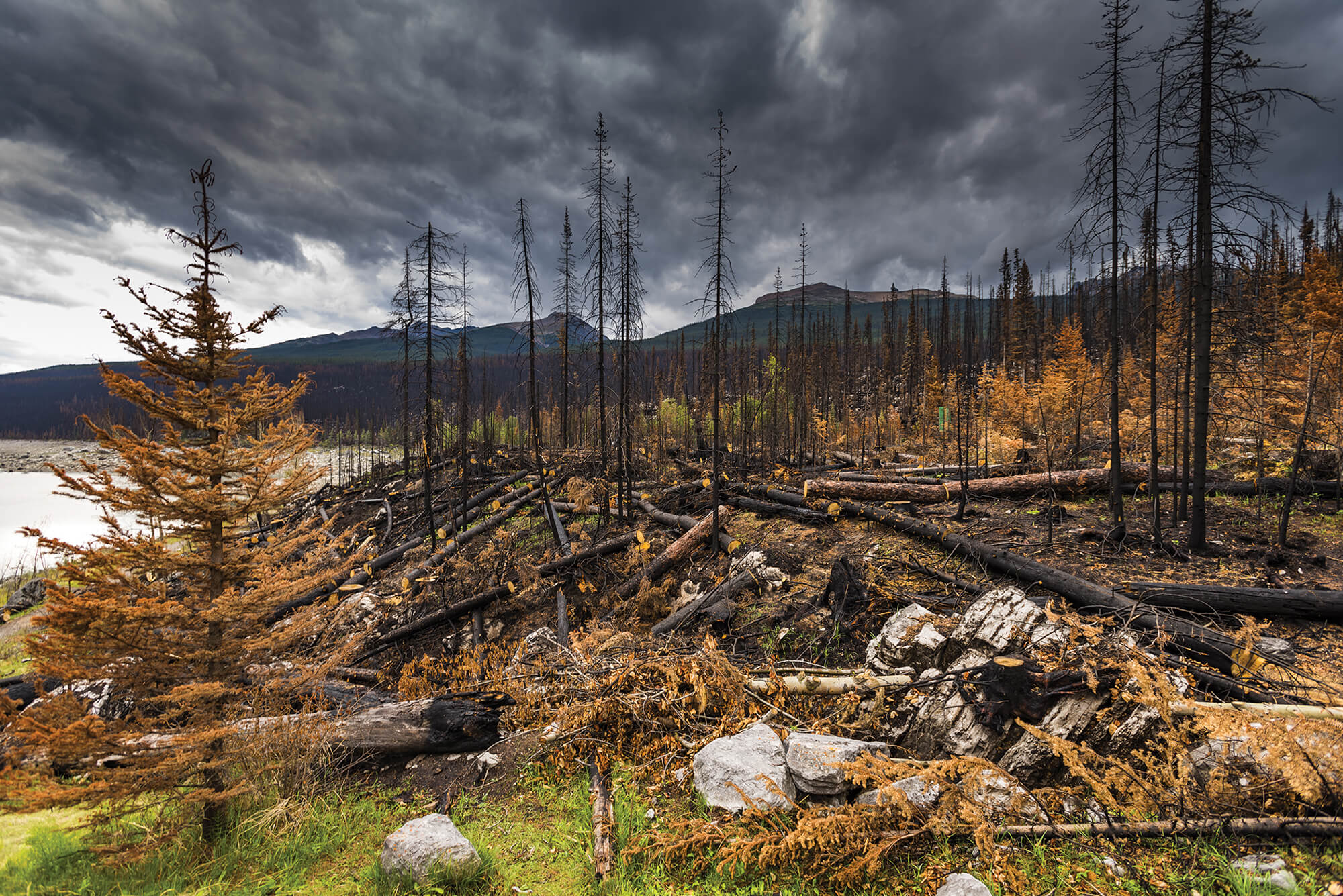October 5, 2023

Wildfire near Osoyoos Lake, British Columbia.
Catching Fire
How thoughtful landscaping can protect homes
BY KARINA SINCLAIR
As the record-breaking 2023 wildfire season in Canada has demonstrated, no one is immune to the effects of scorching temperatures and tinder-dry conditions. It’s been a volatile and eye-opening summer across the country. Toxic smoke and orange haze were inescapable, permeating the air with the smell of charred pine and stinging unease. By Aug. 31, wildfires had burned in all 13 provinces and territories, affecting major swathes of Alberta, British Columbia, Nova Scotia, Ontario, Quebec, Yukon and the Northwest Territories. Scores of communities experienced evacuation orders, leaving many Canadians waiting and wondering if they’d have a home to return to.
A property’s chance of surviving wildfire could depend on the condition of the landscape around it and its readiness to burn. Professional landscapers can make a genuine difference by understanding how certain plants, and their placement, can promote or resist burning.
Karla Hoffman, a horticulturist and arborist in Kamloops, B.C., realized she had more to learn about landscaping best practices in a fire-prone environment back in 2012. In an attempt to reduce water consumption, Hoffman had been recommending plants suited for the local semi-arid climate, such as junipers. A colleague who was involved with FireSmart Canada (a national program dedicated to helping Canadians understand wildfire) reached out to tell her that her advice conflicted with their best practices for fire resiliency. “Having junipers within a certain distance of a structure is a horrible choice from a fire risk perspective,” Hoffman said. “Great from low pest problems, great from the soil perspective, great from a water needs perspective, but awful when it comes to FireSmart. So that was the big thing. I realized I’ve got to learn more about this.”
So Hoffman did learn more, and she encourages her peers to do the same. In this feature, we explore how wildfires grow out of control, and how landscape professionals can think about designing, installing and maintaining more resilient properties.
 Wildfire in Kelowna, British Columbia.
Wildfire in Kelowna, British Columbia.The genesis of gigantic wildfires
Many factors have come together to create what federal Natural Resources Minister Jonathan Wilkinson called the “worst wildfire season on record.” Climate change, compounded by El Niño, has brought hotter temperatures, especially in Canada’s North where the mean temperature has risen by 2.3 C since 1948. Warming in the Arctic has weakened the jet stream, allowing for stationary weather patterns to form, such as heat domes. For every increase in mean temperature, there’s also a 10-12 per cent increase in lightning. Lightning is responsible for starting roughly 50 per cent of wildfires in Canada.Another critical ingredient of wildfire is vegetation. Dense boreal forests have been stressed by drought and ravaged by invasive pests, such as the emerald ash borer and mountain pine beetle. These infected stands become fuel for a very hungry force of nature. A 2014 study by Natural Resources Canada showed flames move two to three times faster through crowns of trees affected by mountain pine beetles compared to healthy green trees.
From deep in the forest to down the street
Wildfires are an important part of nature’s life cycle. They clear out dead vegetation to make way for new growth and help release nutrients into the soil. Wildfires become a danger for people and property when they become powerful enough to advance into the wildland-urban interface (WUI). This is a transitional area where undeveloped wilderness meets human development (think of properties adjacent to provincial parks or even backing onto ravines). From there, it’s just a matter of heat and flames gobbling through fuel sources into more populated areas.According to the Intact Centre on Climate Adaptation (ICCA) at the University of Waterloo, 60 per cent of all cities, towns, settlements and reservations across Canada have a significant risk of damage from wildfires. An estimated 12 per cent of Canadians and up to 80 per cent of Indigenous communities are located within the WUI. A 2022 Fire Underwriter’s Survey by Opta Information Intelligence revealed insured wildfire damage to homes has increased more than 10 times since 2000. Nearly three quarters of Canadians live in large urban centres, according to Statistics Canada. Since wildfire risk is considered to be low in these areas, it can be tempting to ignore FireSmart recommendations when installing and maintaining properties in metropolitan areas.
Cheryl Evans is the director for flood and wildfire resilience with Intact Centre on Climate Adaptation, and also has a background in landscape design. She understands why landscapers and homeowners outside a WUI might hesitate to adopt FireSmart guidelines, but points out that extreme temperatures have left urban canopies (like ash trees) stressed and vulnerable to disease and pests.
“They’re standing dead, waiting to go if there’s a lightning strike or some person throws a cigarette. There are sparks that get away and you can have a grass fire,” Evans said. “So we need to think: what are the current drought conditions? What are the stress conditions for the trees? And what are the conditions projected to be in the future? How do we make sure we are building in ways that are resistant to ignition by fire? It is a lower risk [in urban areas] but we still want to be vigilant.”
 Aftermath of a forest fire, Jasper, National Park, Alberta.
Aftermath of a forest fire, Jasper, National Park, Alberta.Fire at the front porch
When conditions are prime, wildfires have the power to travel great distances quickly. A Home Owner’s FireSmart Manual states crowning forest fires often spread at up to 5.5 kilometres per hour. They can also produce burning embers that can travel several kilometres in the wind before falling, and still be capable of spreading fire given the right fuel. If even a tiny spark lands on fuel (such as dry, dormant turf, unhealthy trees with low branches or canopies arching over a roof, fallen pine needles and brush, wood piles, and so on), there’s major potential for combustion and damage to a home. In fact, research shared by the Intact Centre on Climate Adaptation says an estimated 50-90 per cent of home fires attributed to wildfire are ignited by embers.If an ember lands on a home or yard that has been optimized for fire resilience, though, it will typically burn out or remain small enough for fire crews to extinguish it before it spreads.
That’s why FireSmart Canada is on a mission to help identify ways to improve our resilience to wildfire risk at home. The non-profit was founded over 20 years ago and provides practical recommendations that address wildfire concerns, based on post-fire inspections and research performed at living labs and test plots, where various construction and landscaping materials are tested in fire simulations.
Each province has their own recommendations, tailored to their climate and topography. FireSmart BC also created a resource hub for professional landscapers that offers strategic recommendations for where, and what, to plant to build resilience.
Since homes and their surrounding areas are particularly vulnerable, FireSmart prioritizes the zones within 10 metres from the home (see sidebar for more). When considering landscaping with fire protection in mind, addressing the zone within 10 metres of a home has the biggest impact. If this area is an open, fuel-free space, burning embers landing here are much less likely to spark a critical situation.
Spreading the message, not misinformation
To help landscapers understand their role in fire risk mitigation, a national committee involving FireSmart, the Fire Chiefs Association of British Colombia, the Intact Centre on Climate Adaptation at the University of Waterloo and Canadian Nursery Landscape Association is developing standardized training for all landscape professionals. The foundational course is expected to be delivered online, with future modules being added to reflect different provincial specifications. Landscapers who complete the course would be recognized and accredited in FireSmart fundamentals.Evans, who is part of the course planning committee, acknowledges that homeowners might balk at the idea of replacing beloved garden beds close to their homes. “You have to get the contractors excited, but they have to be able to motivate their clients to get excited. Some residents would say ‘I don’t know if this actually works so why would I do this?’” She recommends contractors frame resilient landscape designs in a way that matters to their clients, by demonstrating their beauty, comfort, affordability, and of course, safety.
Hoffman, the landscape consultant from Kamloops, represents FireSmart BC on the committee, and was also a key contributor to the FireSmart BC Landscaping Guide. “The idea behind this course is to target people already in the industry and give them the knowledge and information so that when they’re out there making recommendations, they’re good recommendations.”
Landscapers may mistakenly assume adopting FireSmart principles will impact their creative choices; Hoffman hopes the training will demonstrate it’s still possible to create landscapes with beautiful design and function. “That’s the point — getting the knowledge out there to folks so that they realize that you still can achieve those things. And we just have to be a little more creative or substitute different materials.”
Choosing fire-resistant plants and materials
By incorporating fire-resistant plants, landscapers can still create beautiful designs that will stand up to natural disasters — not all plants are equally combustible. The riskiest plants are those that have aromatic leaves or needles, contain resin or oils, have papery or flaky bark, and accumulate fine, dry dead materials. Instead, look for plants that have moist, supple leaves, low amounts of sap or resin, and accumulate minimal dead vegetation. Some participating nurseries even stock and label wildfire resilient plants.The FireSmart BC landscaping hub also includes a searchable database of fire-resistant plants that categorizes them by hardiness zone, sun/shade requirements, water use, suitability for pollinators and so on.
It may be hard to believe that swapping out plant choices or tidying a yard can make much difference when faced with a monstrous wildfire, but Evans says every small action done at the lot level is crititally important. “The 10 metres from where a home and attachments are — that is a single most critical influence on whether a home is going to be slightly damaged, destroyed or able to completely survive a wildfire,” Evans said. Landscape maintenance crews can reduce risk by ensuring fallen leaves and pine needles are raked up, thirsty plants are replaced with drought-resistant options and trees are properly trimmed.
If the landscape design includes adding structures, the FireSmart home construction guide recommends using noncombustible or fire-resistant materials such as Class A fibreglass roofing shingles and tempered glass porch railings. For decks, use noncombustible flashing at deck/house wall junctions and sheath the underside of the deck in fire-resistant materials, such as metal screening, to prevent embers falling through boards.
What’s next?
Researchers have identified several concerning trends when it comes to climate change. The fire season now starts one week earlier and extends one week later than it did when records started being kept 70 years ago. Evans says by the end of this century, it is expected that the fire season will lengthen by an additional 30 days. The whole country will feel the effects, but the Atlantic provinces can expect to see hot wildfire season days increase by 200-300 per cent. “They don’t have a very long or impactful wildfire season now, but the hot, dry weather will impact them and be quite a shock to the system. They’re not as prepared as B.C. or Alberta,” Evans said. “It’s important to look at the current climate projections and say ‘What can we expect in the future? How can we be thinking about landscaping?’Hoffman feels an obligation to apply her FireSmart insights by suggesting safer practices for her clients. Whether the client chooses to adopt the measures or not, she knows she is giving them an educated choice, which reduces anxiety for all involved. “Knowing what I know now, as much as I want a landscape to look a certain way, I just wouldn’t want to be responsible for contributing to fire risk on a home,” she said. “Ignorance is bliss, but once you know something, you have a responsibility to use those best practices.”

Tips for landscapers by FireSmart Canada
Firesmart Canada recommends landscapers plan based on ‘zones’ corresponding to their proximity to the home.
Priority Zone 1a (Immediate zone): 0 — 1.5 metres from the home
Create a noncombustible zone around the building and any attachments (such as decks, porches, balconies and pergolas). Landscaping stones, pavers, concrete or bare soil would be suitable in this immediate zone. If healthy trees are already established and must remain, prune at least two metres up from the ground.
Priority Zone 1 (Intermediate zone): 1.5 — 10 metres
Here, landscapers can plant fire-resistant plants, trees and shrubs in low density (keeping mature sizes in mind), while still avoiding bark mulch, woody debris and evergreen or coniferous trees. Woodpiles should be relocated at least 10 metres away from the home. Keep grass watered and mowed.
Priority Zone 2 (Extended zone): 10 — 30 metres
If this area is within your control, thin the amount of shrubs and trees so the crowns are three to six metres apart to reduce the potential for a crowning fire. Make it less crowded, so if a fire does happen, it’ll burn less fiercely and be easier to put out.
Priority Zone 3 (Extended zone): 30 — 100 metres
This extends beyond many typical lot sizes, but should be considered when planning neighbourhood green spaces and properties adjacent to densely wooded areas. City planners, parks departments, property developers, IPM specialists and landscape architects all have influence in creating resilient buffer zones.